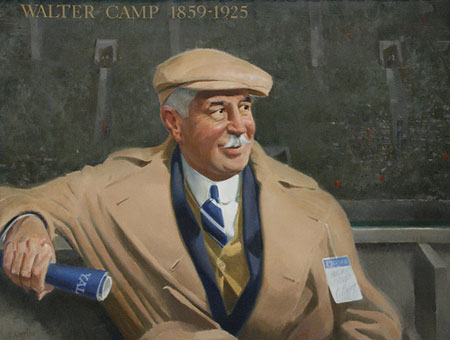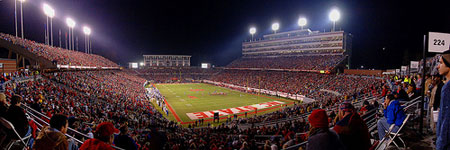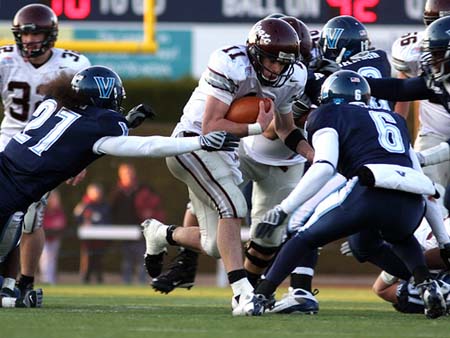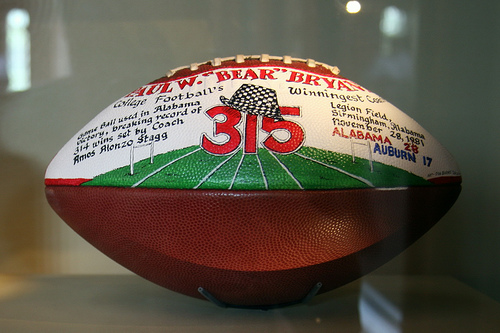NCAA football history goes back to the very birth of the National Collegiate Athletic Association (NCAA) in 1905. In fact, the NCAA owes its very existence to football. Yes, it's true. Without football, there never would have been an NCAA. This is because the reason the NCAA was formed was to "fix" the game of football.
At the outset we should note that football, even college football, did not begin with the NCAA. It predates the NCAA. The game of what is today known as American football has its roots in mid-1800's England; with the game of rugby.
The game, or more correctly "games" (because there were many variations of it), spread primarily to colleges in Canada (by British soldiers) and then to campuses in the northeastern United States.
The first recorded game called "football" played between American colleges was a game between Rutgers and Princeton in 1869. Rutgers won by a score of 6 "runs" to 4. Yale, Harvard and Tufts all had notable teams in this time. Here's an interesting article discussing the Early College Football Rules adopted by Princeton.
Walter Camp is known as the "Father of American Football." This is because he came up with the idea of a "scrimmage line" instead of a "scrum" and a host of other modern elements we now take for granted including the eleven-man teams; most of the scoring we now have; the traditional offensive lineup with seven men on the line four in the backfield. Camp was also instrumental in popularizing the game by publishing many articles in popular magazines like Collier's Weekly and Harper's Weekly. He also chose college football's very first All-America Team.
 Walter Chauncey Camp (April 7, 1859 – March 14, 1925) was a sports writer and American football coach known as the "Father of American Football".
Walter Chauncey Camp (April 7, 1859 – March 14, 1925) was a sports writer and American football coach known as the "Father of American Football".
Thanks to dbking at flickr.com for the picture.
So, college football was increasing in popularity through the end of the 19th and early in the 20th century. One big problem though was that the game was also increasingly violent. Players wore little in the way of protection and after a series of deaths resulting from football injuries, President Teddy Roosevelt threatened to ban the game. This brings us to 1905 -- the beginning of NCAA football history.
In the year 1905, football was known as a rugged game, where there were mass formations and gang tackling -- very similar to rugby. There were numerous injuries, and even deaths, reported to have occurred from playing American style "football". The "flying wedge" formation was allegedly responsible for many of these. This prompted many college institutions to discontinue football as a sport. Other institutions wanted football to be reformed, with new rules to make it a safe game for the students to play. These colleges stated that unless football was reformed it would be abolished from intercollegiate athletics.
 NCAA Tournament balloons. Thanks to bp6316 at flickr.com for the picture.
NCAA Tournament balloons. Thanks to bp6316 at flickr.com for the picture.
The issues with football caught the attention of Pres. Theodore Roosevelt, who arranged two White House conferences with college athletic leaders to encourage reforms of the game. After these two White House conferences in December of 1905 New York University Chancellor Henry M. McCracken convened a meeting, including 13 college institutions to initiate changes in the football playing rules for the colleges.
Later that same month in New York City, the Intercollegiate Athletic Association of the United States was formed and included 62 members. The IAAUS was officially constituted on March 31 of 1906. This association was a discussion group and rules making body for college football. In the year 1910, the official name of the IAAUS was changed to the NCAA. In fact we recently dug up this Original (1906) IAAUS (later NCAA) Constitution and By-Laws. Check it out!
 Inside of Carter-Finley Stadium in Raleigh, NC, home of the NC State Wolfpack.
Inside of Carter-Finley Stadium in Raleigh, NC, home of the NC State Wolfpack.
Thanks to maggieandcharles at flickr.com for the picture.
As stated before, the NCAA was originally only concerned with football in the college world. But in 1921 the NCAA held its first national track and field championships. These were known as the National Collegiate Track and Field Championships, and gradually there were more committees formed and more championships held so that the NCAA became the association to handle all college athletics.
After World War II, there was a series of crises that brought the NCAA to a crossroads. A policy called the "Sanity Code" that was adopted to establish guidelines for colleges recruiting and financial aid failed to stop the abuses involving student athletes. Postseason football games were multiplying rapidly and member institutions were concerned about the effects of unrestricted television on the attendance of football games.
 Villanova vs Colgate in the NCAA Football Championship Subdivision playoffs.
Villanova vs Colgate in the NCAA Football Championship Subdivision playoffs.
Thanks to Saquan Stimpson/monstershaq2000 at flickr.com for the picture.
These problems as well as the growth in membership and championships showed an increasing need for a full-time professional leadership of the NCAA. In 1951 previous part-time executive assistant Walter Byers was named as the executive director of the NCAA. In 1952, the NCAA national headquarters was established in Kansas City. At this time, a program to control live television of football games was approved and the annual convention delegated the enforcement powers to the Association's Council and legislation concerning postseason bowl games.
The NCAA's membership was divided into three legislative and competitive divisions. In 1973, five years later, the Division I members voted to create subdivisions (Div I-A and Div I-AA). Football is the only sport with subdivisions in Division I. These subdivisions were subsequently renamed the Football Bowl Subdivision and the Football Championship Subdivision.
 This game ball was presented to University of Alabama coach Pawl W. "Bear" Bryant (1913-1983) upon becoming the "winningest" coach in NCAA football history, a record which he held for 20 years. Thanks to cliff1066's at flickr.com for the picture
This game ball was presented to University of Alabama coach Pawl W. "Bear" Bryant (1913-1983) upon becoming the "winningest" coach in NCAA football history, a record which he held for 20 years. Thanks to cliff1066's at flickr.com for the picture
In 1998 the Bowl Championship Series (BCS) system was formed. The stated goal was to bring some order to the "chaos" of the bowl system. The idea was to add an extra game each year that would match up the #1 and #2 teams to play for College Football's BCS Championship.
Of course the debate over whether college football should have a playoff system (every other sport does) rages on. But, you'd have to admit that the BCS system has improved things slightly. At least in most years.
You can read more about the BCS vs college football playoff debate at College Football Playoff.
If you are interested in reading more about college football history, here's a great book:
Here's our
Best All Time College Football Articles.
If you are looking for information about Division II or III college football, check out Small College Football History.
Fascinating books about the history of NCAA Football:
Looking for a special gift for the College Football fans Best College Football Gifts
What do you think?
We'd love to hear your comments and/or opinions. If you submit them here, other visitors can read them, rate them and comment on them. An e-mail address is not required.
What Other Visitors Have Said
Click below to see contributions from other visitors to this page...
From NCAA Football History to Best All Time Sports |
Best All Time Sports Blog |
History of Professional Football |
MLB History |
History of NBA |
History of Hockey |
NCAA Basketball History |
NCAA Baseball History |
Small College Football History |
History of College Sports |
Olympic Sports History |
History of All Sports |
Best Moments in Sports History |
Worst All Time Sports Moment |
Current Best All Time Sports News |
Best Sports Forum |
Best Sports Blogs |
NFL Football Apparel and Merchandise |
MLB Baseball Apparel and Merchandise |
NBA Basketball Apparel and Merchandise |
NHL Hockey Apparel and Merchandise |
College Fan Apparel and Merchandise |
Small College Sports Apparel and Merchandise |
Other Sports Fan Apparel and Merchandise |
Best Sports Gifts |
Fathead |
Sports Tickets |
Home Page
About Us |
Contact Us |
Site Search |
Advertise |
Terms of Use |













New! Comments
Leave a comment about this article in the box below and share it with your Facebook friends.